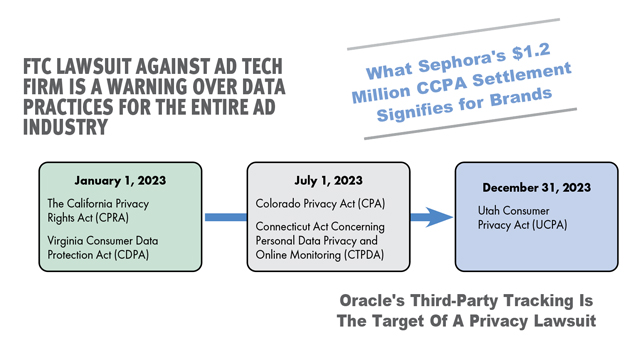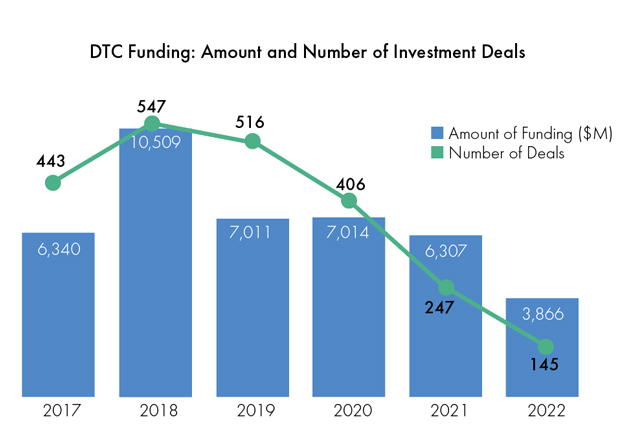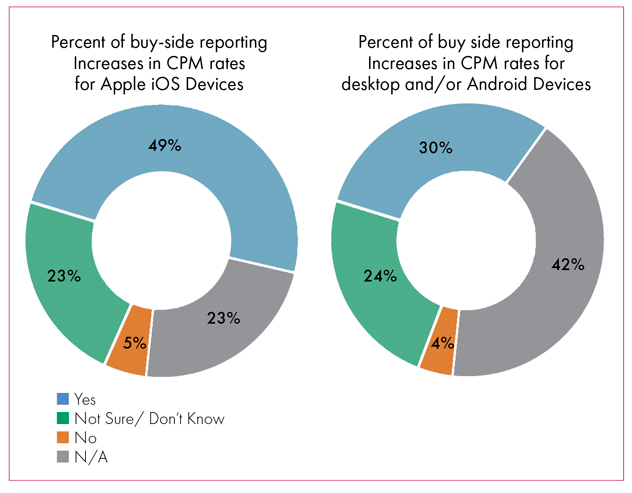Interview with Richard Harris, Orbit Interactive
It’s a perfect storm for digital marketers that threatens substantial legal
exposure, increased compliance costs and reduced clarity in linking digital
spending to ad effectiveness measures.
Over the past 20 years, home furnishings retailers have benefited from a
steady stream of digital marketing advances. These have allowed retailers to
use sophisticated data collection to identify and deliver content to
shoppers in an increasingly granular way. For better or worse, depending on
your view of consumer privacy, all that is about to change.
Furniture World spoke with Richard Harris, Vice President of Digital
Happiness at the marketing agency Orbit Interactive (orbitinteractive.com)
to provide context for legislation that is changing how retailers approach
digital marketing.
Orbit Interactive was founded 15 years ago as a white-label digital
solutions provider. “Along the way,” noted Harris, “we added support for
regional and national ad agencies and now work directly with furniture
retailers.”
He’s worked for Yahoo, Google, CBS, Fox, Cox Media, the federal government,
and others. In 2017 he joined Alex Cantos, Orbit Interactive’s CEO, to
develop ways to help their retail clients bring in customers. “We can do
everything from sending targeted text messages to deliver video to potential
customers at a gas station pump. Today it doesn’t make a difference how
messages are delivered on the digital side. The important question in front
of every home furnishings retailer is ‘What’s the best way to reach a
particular customer?’”
Data Privacy Concerns
“Right now, every retailer should immediately become familiar with states
that already implemented digital privacy policies or will by the end of
2023.”
Over the past two years, data privacy has become one of the main topics of
concern among marketers. Harris noted that legislation is already in place
for 2023 that mandates privacy-safe data collection. Not only will retailers
be held accountable for how they use the data they collect, but they will
also need to validate that this data is stored in a way that keeps it safe
from hacks and other leaks.
“Another huge marketing challenge for Furniture World readers,” he
explained, “is that third-party cookies will disappear. It’s inevitable and
will transition us to a world where retailers cannot legally purchase
behavioral data collected by a third party, then use it to target potential
customers.

No company will be immune from legal penalties as privacy lawsuits are
moving beyond the largest platforms. Ongoing privacy legislation will continue to challenge ad targeting,
measurement, and ROI—crucial tactics that brands require to survive
and thrive. Source: Orbit Interactive.
“I worked on the European side when privacy protections were being put in
place. It was a nightmare, to say the least. But once it was up and running
and everybody knew what the rules were, it was okay. Europe is well ahead of
the U.S. regarding privacy and the internet. For example, in North America,
we’ve rolled out G5 mobile plans, but Europeans already have G6 and are
working on G7.
“The problem for marketers here in the U.S. is that the digital playing
field lacks clarity and consistency. The House Energy and Commerce Committee
approved the American Data Privacy and Protection Act in 2022,” Harris
continued.” The bill states that its purpose is to “provide consumers with
foundational data privacy rights, create strong oversight mechanisms, and
establish meaningful enforcement.”
“Sending an offer based on the exact red sofa someone looked at online is
much more effective than providing a more general discount coupon, but it
requires a website that includes a full inventory feed.”
Harris worries that if that legislation doesn’t move forward, a frightening
can of worms might open that lacks clear and cleanly defined regulations.
That scenario would unnecessarily complicate privacy and transparency in
digital data communications.
Practical Counter-Measures
"The underpinning of this issue, “ Harris said, “is that retailers need to
roll out successful data-driven marketing campaigns that depend on
effectively using consumer data, product data, data trends and platform
data.
“Right now, every retailer should immediately become familiar with states
that already implemented digital privacy policies or will by the end of
2023. These include California, Colorado, Virginia, Connecticut, and Ohio.
“The rules are a moving target, but at the end of the day, affected
retailers will need to provide proof that they are keeping consumer
information private and are not reselling it or using it to do anything
deemed inappropriate. In California and Colorado, retailers will need to
show that information is locked away so that it cannot be stolen. There are
a number of companies popping up to help retailers with compliance.”
Targeting in This New World
“Digital marketing has relied on third-party cookies for some time. In this
world, whether individuals are digitally connected through a cable line,
streaming television or internet connection, Internet service providers can
track their usage. ISPs collect hours, days, and even years of data based on
searches and activities. Every time consumers arrive home from work, their
mobile devices download their caches to internet service providers via
Wi-Fi. When we transition to a cookie-less world, marketers won’t be able to
purchase this customer-specific third-party data. Instead, retailers will
need to use broader measures and apply predictive models that won’t be as
invasive or easy to apply.
“The challenge for marketing going forward,” Harris predicted, “is how to
prepare for doing business in what is now called a zero data or zero-cookie
world.”
“Marketers won’t be able to purchase this customer-specific third-party
data. Instead, retailers will need to use broader measures and apply
predictive models that won’t be as invasive or easy to apply.”
No Cookies for You!
“Without third-party cookies, it will be harder for retailers to identify
individual furniture shoppers unless they visit a retailer’s website or
directly engage with a store.“ Harris said, “Retailers will still be able to
target based on demographics, spending power or a customer’s purchase
history. But going forward, the highest value information used for retail
marketing will come from shoppers who visit websites and voluntarily leave
their information. That’s why retailers that are not doing everything they
can to facilitate first-party data collection on their websites will find
themselves in a very bad place.
“Without this first-party data, they will be at the mercy of Google,
Facebook and Amazon,” observed Harris. “These three companies hold 83
percent of all the data out there and have no problem charging retailers
whatever they want.”
Why Ruin a Good Thing?
Harris noted, “Third-party data is generated based on the places people
click, pages they visit and keywords they search—leaving a trail of
breadcrumbs across the web. That’s why federal and state government bodies
and companies concerned with transparency are working to eliminate it. It’s
not a secret to consumers that companies can and do know everything about
them. For example, it’s easy to predict with some certainty how often, and
the exact day, an individual consumer will go grocery shopping. And, with
that information in hand, marketers can deliver ads timed to affect a next
grocery purchase.
“From any retailer’s perspective, the marketing goal is to deliver ads that
are more targeted, timely and effective. But when consumers feel like
they’re being spied upon, they feel uncomfortable. That’s why we have a
transparency issue right now. Marketers are being challenged to create new
ways to deliver the best ad information possible to prospects without
digging too deep into their personal lives.”
First-Party Data Will be OK
First-party data will not be affected by new digital norms because consumers
will have a choice of whether or not to accept cookies.
“Accepting a cookie is a type of digital handshake that says to a visitor,
‘Now we know who you are,’” Harris explained. We can verify if you’ve been
here before, and we will continue to add all the new pages and items you
look at to the information we already know about you.’ This cookie data
provides retailers with a profile of who a shopper is, how long they’ve been
looking for something and what they are interested in purchasing. For some
website visitors, it’s one page in and one page out. Others will have
visited a retailer’s site multiple times and looked, for example, at every
possible dining table shown on their website over a period of months. Having
this first-party data in hand presents an opportunity for a retailer to send
special offers for the exact sofa a customer has landed on most often.

Signal Loss: Brands have been forced to measure success with metrics
that are less reliant on depleted signals.
Weighted Acquisition Cost (WAC)= Total Ad Spend/ Number of New eCom
Customers
Advertising Cost of Sales (ACOS) = Total Ad Spend/ Total eCom
Revenue
Marketing Efficiency Rating (MER) = Sales Revenue/ Total Ad
Spend
“Most furniture retailers are not using collected data to do this,” observed
Harris. “Some are performing general site re-targeting based on identifying
consumers who visited their website. They may be able to determine that a
shopper has looked at sofas or even, for example, mostly red sofas. Sending
an offer based on the exact red sofa someone viewed online is much more
effective than providing a more general discount coupon, but it requires a
website that includes a full inventory feed.”
First Steps Toward Compliance
Furniture World asked Harris to share the steps retailers might take to
collect and effectively use first party data.
“Leveraging first-party data in a dynamic way,” he replied, ”is going to be
very important in 2023 and an absolute necessity for furniture retailers in
2024.
“The first checklist item is to find a way to collect it. There are basic
ways such as asking visitors if they want to sign up to receive a
newsletter. And, of course, asking for that cookie.
“Next, a plan must be put in place to store data. Will it be stored in the
cloud on a platform like Snowflake (snowflake.com). If so, what guarantees
are there that the data collection and storage are secure? Once data is
collected, further decisions need to be made regarding the specific
information needed to make website visitors more likely to buy.”
Find Your VDP
Harris noted that in the automotive world, website visitors who spend more
time viewing a VDP (vehicle description page) are more likely to show up to
test drive a vehicle. “It’s the page,” he said, “that explains how much a
car weighs, how big the trunk is, back seat legroom and other details.
 Consumers are (understandably) becoming more cautious and selective
about the information they’re willing to share with brands. According to
a recent Prosper Insights & Analytics survey, over 44% of adults 18+
have denied permission for mobile apps to track their activity, and 33%
have turned on private browsing to protect their digital privacy.
Consumers are (understandably) becoming more cautious and selective
about the information they’re willing to share with brands. According to
a recent Prosper Insights & Analytics survey, over 44% of adults 18+
have denied permission for mobile apps to track their activity, and 33%
have turned on private browsing to protect their digital privacy.
“First-party data that identifies website visitors who spend time on VDPs
gives dealers an opportunity to re-market to those shoppers. Auto dealers
may present website visitors with the next feature or benefit of a car
they’ve shown an interest in, encourage them to set up a test drive or
provide additional value incentives on a particular vehicle.
“Furniture retailers generally don’t use their first-party data in this way.
Even if they track the number of website visits and page views over time to
provide a measure of ad buy effectiveness, they could do so much more to
engage and re-market based on the first-party data they collect.
“Obviously, there are players in the home furnishings market that use
advanced techniques, but many haven’t changed their marketing strategies
much over the past 20 years. These players need to find a way to drive
walk-in store traffic other than continuing to scream sale, sale, sale.”
“Digital privacy is going to be lawsuit as well as paperwork driven,” he
predicted. “California is already starting to stretch its legs in this area.
Sephora recently paid $1.2 million to settle a lawsuit as part of the
state’s enforcement of the California Consumer Privacy Act. There have been
other fines levied as well, though most so far have been ‘shots across the
bow’ to warn retailers to pay attention. Larger companies not located in
California but that do business there can also be fined. Be aware that fines
can add up quickly because the CCPA includes provisions to penalize
retailers per customer incident.
Legal Exposure
In the January/February issue of Furniture World, industry observer Tom
Liddell spoke about the risk of lawsuits against retailers for non-ADA
compliance (see
www.furninfo.com/furniture-world-articles/4039). Harris noted that web privacy data compliance will present a similar,
possibly larger risk.
“Digital privacy is going to be lawsuit as well as paperwork driven,” he
predicted. “California is already starting to stretch its legs in this area.
Sephora recently paid $1.2 million to settle a lawsuit as part of the
state’s enforcement of the California Consumer Privacy Act. There have been
other fines levied as well, though most so far have been ‘shots across the
bow’ to warn retailers to pay attention. Larger companies not located in
California but that do business there can also be fined. Be aware that fines
can add up quickly because the CCPA includes provisions to penalize
retailers per customer incident.
“We’ve all seen news stories about huge judgments against banks, the result
of class action lawsuits, for failing to protect client financial and
personal data. From now on, furniture retailers may be held liable for data
breaches of furniture shopping information. “That’s why every retailer needs
to ask the following questions:
 Signal loss, the result of operating system privacy change, is a key
driver of decreased DTC company valuation and funding. Unable to
optimize effectively, Direct To Consumer (DTC) companies are now
spending more money to get fewer results. “The iOS 14 privacy changes
affected everything... The internal metrics and mechanisms that Meta
uses for attribution are off somewhere around 30, 40 or 50%.” Source:
David Herrmann, Herrmann Digital, LLC.
Signal loss, the result of operating system privacy change, is a key
driver of decreased DTC company valuation and funding. Unable to
optimize effectively, Direct To Consumer (DTC) companies are now
spending more money to get fewer results. “The iOS 14 privacy changes
affected everything... The internal metrics and mechanisms that Meta
uses for attribution are off somewhere around 30, 40 or 50%.” Source:
David Herrmann, Herrmann Digital, LLC.
- How do I put data in a secure lockbox?
-
What client data is sitting on an insecure hard drive somewhere in an
excel sheet or a Google Doc format?
-
How can I protect myself from a hack that results in a class action suit?
“Clearly, customer information can no longer sit on an external hard drive
or be backed up in Dropbox. Understandably, a single-store furniture
retailer might not want to spend $2,500 a year on a privacy system, but the
cost of not doing so may prove to be a business-ending mistake.”
Cookie Questions
We’ve all seen websites, especially those for European-based companies,
which allow visitors to choose the kinds of cookies they will accept along
with detailed explanations (See an example at
https://www.natuzzi.com/us/en/cookie-policy). The choices vary, but may include options to allow retailers to use
cookies that are labeled necessary, used to collect statistics or for
marketing purposes.
“U.S. regulations will be basically the same as Europe’s,” explained Harris.
“Europeans can also view data already collected about them, then correct or
remove it. I’ve not seen a single U.S. retailer that has this functionality.
It’s one of the current requirements mandated in the California and Colorado
regulations as of January 2023.”
Consumer Behavior: “Research shows that when a visitor
encounters a website that provides a choice of cookie options, about 25
percent of consumers just say ‘no’ and continue to browse the site. The
result is that the site owner can’t collect data on those visits. At the
same time, about 35 percent of visitors ignore the question and continue to
trudge on through. Technically those who don’t answer shouldn’t be allowed
to proceed, but many websites allow them to do it anyway.”
Out of Compliance: “Lots of U.S. retailers are already out
of compliance and need to play catch up. Our company can advise our clients
on certain aspects of security and privacy, but retailers need to hire an
experienced specialist to help them handle data security. We are
investigating a number of these companies and will be glad to suggest names
to Furniture World readers. One that looks promising is Safeguard Privacy
(safeguardprivacy.com). There
will probably be 100 more to add to this list over the next six months.
“Clearly, California-based retailers and others that are or will be out of
compliance soon, have a pressing need to get this done quickly.”
Business Nexus: “Originally, California said retailers with
headquarters in other states were obligated to follow California Consumer
Privacy Act rules. They have loosened that requirement up a little bit. For
out-of-state retailers that do significant sales volume in California,
there’s a substantial risk. A small retailer headquartered outside of
California that happens to have a couple of customers in there is probably
OK.”
 Industry leaders say their revenue and margin won’t be affected but the
data shows that the buy-side has been hit financially: Approximately
half are seeing increased CPMs on iOS and 30% are seeing increased CPMs
on Android following Apple’s iOS 14.5 release. Source: Internet
Advertising Bureau research’s 2022 survey of brands and agencies.
Industry leaders say their revenue and margin won’t be affected but the
data shows that the buy-side has been hit financially: Approximately
half are seeing increased CPMs on iOS and 30% are seeing increased CPMs
on Android following Apple’s iOS 14.5 release. Source: Internet
Advertising Bureau research’s 2022 survey of brands and agencies.
Smart Phone Privacy Changes
When asked about recent updates to smartphone privacy, Harris explained that
“Starting with the iPhone OS14 update in late 2020, mobile phone users have
been able to turn off ID location so marketers can’t track their devices.
“Right now, they can still collect information using a mobile ad ID (MAID)
that’s part of every mobile app out there. But it’s only useful for tracking
when an app is turned on. The result is that marketers have lost a lot of
marketing insight due to a large drop in their ability to see shoppers’
mobile devices.
“This loss doesn’t mean that geofence is going away, but it’s not as useful
as it used to be for targeting potential customers. At this point, everyone
is trying to develop a mobile strategy that’s scalable and reliable while
meeting privacy and addressability rules.
“Are there going to be new ways to improve our ability to market using
mobile devices? I believe that there will be. But I don’t see a technology
combined with platforms that promises a truly bulletproof and future-proof
ROI to get there right now.”
What Remains For Marketers?
Harris says that there are a lot of products out there that retailers can
effectively use. It just means geofence may not be the one that’s best for
some retailers. “Five years ago,” he recalled, “retailers could put a
geofence on their competitors, target them with ads, then see how many
people walked into their stores. Today, running the same number of ads on
top of the same geofence might result in being able to identify just
one-twentieth of the number of walk-ins. Five years ago, we could verify the
advertising ROI. Today we are forced to guesstimate. There are some ways to
get around this issue, but the current mobile device situation has forced
retailers to use traditional measures of ad effectiveness.”
That doesn’t mean that the advertising isn’t turning shoppers into buyers,
Harris explained. “Only that it’s going to be harder to measure. Many
retailers will need help from companies having access to a database of
results achieved by other similar retailers. Ideally, this information
should be driven by AI or data collected from multiple clients, tested on a
variety of platforms with thousands of clients in diverse markets.”
Conclusion
The fact is that the advertising landscape is changing right now due to the
convergence of lots of factors.
Harris said that some of this change will be driven by the recent turnaround
in the profitability of tech giants. “It will cause them to change their
policies and ways of doing business.
“And, as we’ve discussed previously,” he continued, “privacy legislation has
the potential to hurt both large and small home furnishings retailers.
Successful companies will focus on the entire marketing ecosystem then
utilize every tool available to compensate by handling privacy compliance in
the right way. A big part of achieving success will be to utilize organic
website traffic to maximize the collection and use of first-party data.
Remember that at least 80 percent of the people visiting retailers’ websites
don’t buy anything. Not doing enough right now to leverage those visits has
the potential to be a big miss for a lot of retailers,” concluded Harris.